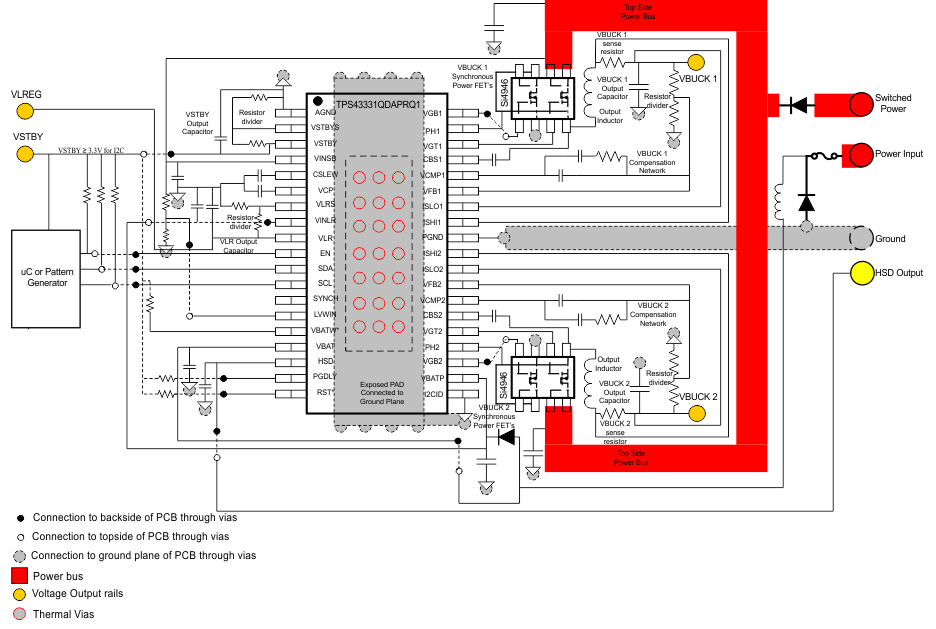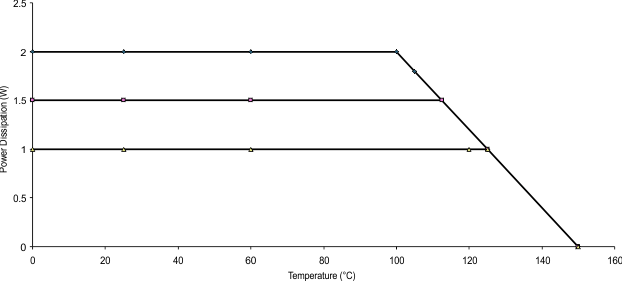SLVSA38B December 2009 – July 2017 TPS43331-Q1
PRODUCTION DATA.
- 1 Features
- 2 Applications
- 3 Description
- 4 Revision History
- 5 Pin Configuration and Functions
-
6 Specifications
- 6.1 Absolute Maximum Ratings
- 6.2 ESD Ratings
- 6.3 Recommended Operating Conditions
- 6.4 Thermal Information
- 6.5 DC Electrical Characteristics
- 6.6 I2C Interface Electrical Characteristics
- 6.7 Switching Regulators Electrical Characteristics
- 6.8 Standby Regulator (VSTBY) Electrical Characteristics
- 6.9 Linear Regulator (VLR) Electrical Characteristics
- 6.10 High-Side Driver (HSD) Electrical Characteristics
- 6.11 AC Switching Characteristics
- 6.12 I2C Interface Switching Characteristics
- 6.13 Switching Regulators Switching Characteristics
- 6.14 Linear Regulator Switching Characteristics
- 6.15 High-Side Driver (HSD) Switching Characteristics
- 6.16 Timing and Switching Diagrams
- 6.17 Typical Characteristics
-
7 Detailed Description
- 7.1 Overview
- 7.2 Functional Block Diagram
- 7.3
Feature Description
- 7.3.1 Unregulated Battery Input Voltage (VBAT)
- 7.3.2 Protected Unregulated Battery Input Voltage (VBATP)
- 7.3.3 Low-Voltage Warning Input (LVWIN)
- 7.3.4 Voltage Warning Output (VBATW)
- 7.3.5 Low-Voltage Reset (RST)
- 7.3.6 Power-Good Delay Timer Input (PGDLY)
- 7.3.7 Active Mode Enable Input (EN)
- 7.3.8 Slew Rate Control Capacitor Input (CSLEW)
- 7.3.9 Charge Pump Capacitor Input (VCP)
- 7.3.10 Power Ground (PGND)
- 7.3.11 Analog Ground Reference (AGND)
- 7.3.12 Inter-IC Communications Interface (I2CID)
- 7.3.13 Clock Input (SCL)
- 7.3.14 Data Line (SDA)
- 7.3.15 Interface Chip Identifier (I2CID)
- 7.3.16 Switch Mode Regulators
- 7.3.17 Upper FET Gate Drive Outputs (VGT1 and VGT2)
- 7.3.18 Lower FET Gate Driver Outputs (VGB1 and VGB2)
- 7.3.19 Bootstrap Capacitor Input (CBS1 and CBS2)
- 7.3.20 Phase Reference for High-Side Bootstrap Supply (PH1 and PH2)
- 7.3.21 Current Sense High-Side (ISHI1 and ISHI2)
- 7.3.22 Current Sense Low-Side (ISLO1 and ISLO2)
- 7.3.23 Regulated Output Sense Voltage Feedback (VFB1 and VFB2)
- 7.3.24 Feedback Compensation Input (VCMP1 and VCMP2)
- 7.3.25 Synchronization Input (SYNCH)
- 7.3.26 Standby Linear Regulator Input (VINSB)
- 7.3.27 Standby Regulator Output (VSTBY)
- 7.3.28 Standby Regulator Sense Voltage (VSTBYS)
- 7.3.29 Switched Linear Regulator Input (VINLR)
- 7.3.30 Switched Linear Regulator Output (VLR)
- 7.3.31 Switched Linear Regulator Sense Voltage (VLRS)
- 7.3.32 High-Side Driver Output (HSD)
- 7.4 Device Functional Modes
- 7.5 Programming
- 7.6 Register Map
-
8 Application and Implementation
- 8.1 Application Information
- 8.2 Typical Application
- 8.3 System Example
- 9 Power Supply Recommendations
- 10Layout
- 11Device and Documentation Support
- 12Mechanical, Packaging, and Orderable Information
Package Options
Mechanical Data (Package|Pins)
- DAP|38
Thermal pad, mechanical data (Package|Pins)
- DAP|38
Orderable Information
10 Layout
10.1 Layout Guidelines
10.1.1 Grounding and Circuit Layout Considerations
The TPS43331-Q1 has two separate ground termination (AGND and PGND) pins. The ground signal consists of a plane to minimize impedance. Try to separate the low-signal ground termination from the power-ground signal. The high-power noisy circuits, such as the output, synchronous rectifier, MOSFET driver decoupling capacitor, and the input capacitor, should be connected to the PGND plane. The AGND plane should only make a single point connection to the PGND plane.
The sensitive nodes, such as the feedback resistor divider, oscillator resistor (to set frequency), current sense, and compensation circuitry, should be connected to the AGND plane.
Try and minimize the high current-carrying loops to a minimum by ensuring optimal component placement. Ensure the bypass capacitors are located as close as possible to the respective power and ground pins.
Sensitive circuits, such as sense feedback , frequency setting resistor for the oscillator, current sense and compensation circuits, should not be located near the dv/dt nodes which include the gate drive outputs, phase pins, and boost circuits (bootstrap).
10.2 Layout Example
 Figure 41. PCB Layout
Figure 41. PCB Layout
10.3 Power Dissipation Derating
The power dissipation curve (see Figure 42) is based on attachment of the exposed power pad to the printed circuit board with multi layer FR4. The data is based of JEDEC JESD 51-5 standard board with thermal vias and high-K profile. The user must review PowerPAD Thermally Enhanced Package Application Report for recommended method of exposed pad attachment.
 Figure 42. Power Dissipation Derating
Figure 42. Power Dissipation Derating